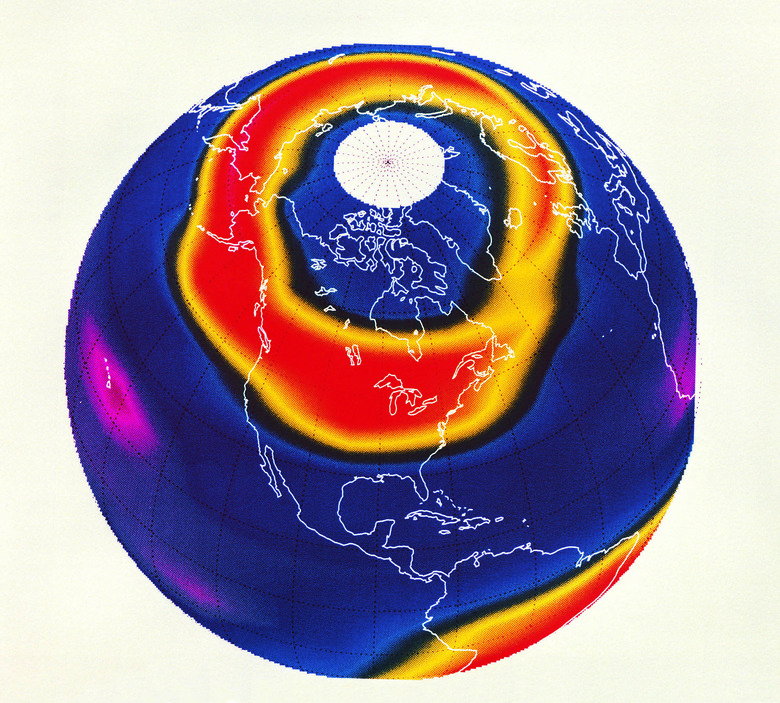How Does Chlorine Affect The Ozone Layer?
Ozone, a form of oxygen, is not an abundant compound in the Earth's atmosphere, but it is an important one. Ozone forms a layer in the stratosphere that works to block harmful ultraviolet solar radiation. Without that crucial layer of ozone, conditions at the surface of Earth would be less favorable for living beings. More harmful ultraviolet rays reaching the Earth's surface would result in higher levels of skin cancer, eye damage and more.
The release of chlorofluorocarbons into the atmosphere damages this ozone layer. This occurs because chlorine – a component of CFCs – is highly reactive and interacts with the ozone to turn it into ordinary oxygen molecules which do not block the harmful ultraviolet radiation.
Different Types of Ozone in the Atmosphere
Different Types of Ozone in the Atmosphere
Ozone is a compound formed from three oxygen atoms, and it exists in two separate layers in the atmosphere. In the troposphere, near the ground, it is considered a pollutant. It damages crops and causes respiratory ailments in humans. This ozone primarily occurs through chemical reactions between sunlight and pollutants emitted by cars, chemical plants and other industrial processes. Scientists refer to this layer as "bad" ozone.
The ozone in the upper stratosphere, however, forms a crucial layer that absorbs ultraviolet sunlight. Scientists measure the thickness of this layer of "good" ozone in Dobson units, named after British physicist Gordon Miller Bourne Dobson, a pioneer in the study of ozone. One Dobson unit is defined as a thickness of 0.01 millimeters (0.0004 inches) at standard temperature and pressure, which is 0 degrees Celsius (32 degrees Fahrenheit) and 1 atmosphere.
Chlorine's Reaction With Ozone
Chlorine's Reaction With Ozone
Chlorine acts as a catalyst in turning ozone into oxygen in a reaction that wasn't fully understood until 1973. When a free chlorine atom and an ozone molecule interact, the chlorine atom strips the third oxygen molecule to form chlorine monoxide, an unstable compound, and leave a stable oxygen molecule.
Because the chlorine monoxide molecule is unstable, it can interact with a free oxygen atom to produce another molecule consisting of two oxygen atoms. This interaction, unfortunately, leaves behind a singular free chlorine atom. This free chlorine atom then starts the entire process again, creating a vicious cycle of ozone destruction. This cycle can repeat thousands of times, steadily decreasing the amount of ozone.
Sources of Chlorine Pollution in the Atmosphere
Sources of Chlorine Pollution in the Atmosphere
Because chlorine is unstable, it would, if released in its elemental form, react with some other element or compound before it ever reached the stratosphere. However, chlorine is a key element in a class of substances called chlorofluorocarbons, which have a number of applications in industry, including refrigeration.
Unlike pure chlorine, chlorofluorocarbons (CFCs) are inert, and when released at ground level, they retain their structure indefinitely. They eventually migrate into the upper atmosphere, however, where the sunlight is intense enough to break them apart and release chlorine. Chlorine isn't necessarily the only element that depletes ozone. Bromine, hydrogen and nitrogen also do this.
The Ozone Hole
The Ozone Hole
The thickness of the ozone layer averages around 300 to 500 Dobson units, which roughly corresponds to the thickness of two stacked pennies. In 1984, British scientists in the Antarctic reported a recurring thinning of this layer to 180 Dobson units, or a little more than the thickness of one penny.
This thinning occurs during the Antarctic winter and spring, when stratospheric clouds of ice particles hasten the destruction of ozone. The hole grows every year to encompass most of the Antarctic continent and beyond, and the layer has become as thin as 73 Dobson units in some years, which is less than the thickness of a dime.
Cite This Article
MLA
Deziel, Chris. "How Does Chlorine Affect The Ozone Layer?" sciencing.com, https://www.sciencing.com/chlorine-affect-ozone-layer-4877/. 20 October 2021.
APA
Deziel, Chris. (2021, October 20). How Does Chlorine Affect The Ozone Layer?. sciencing.com. Retrieved from https://www.sciencing.com/chlorine-affect-ozone-layer-4877/
Chicago
Deziel, Chris. How Does Chlorine Affect The Ozone Layer? last modified March 24, 2022. https://www.sciencing.com/chlorine-affect-ozone-layer-4877/
